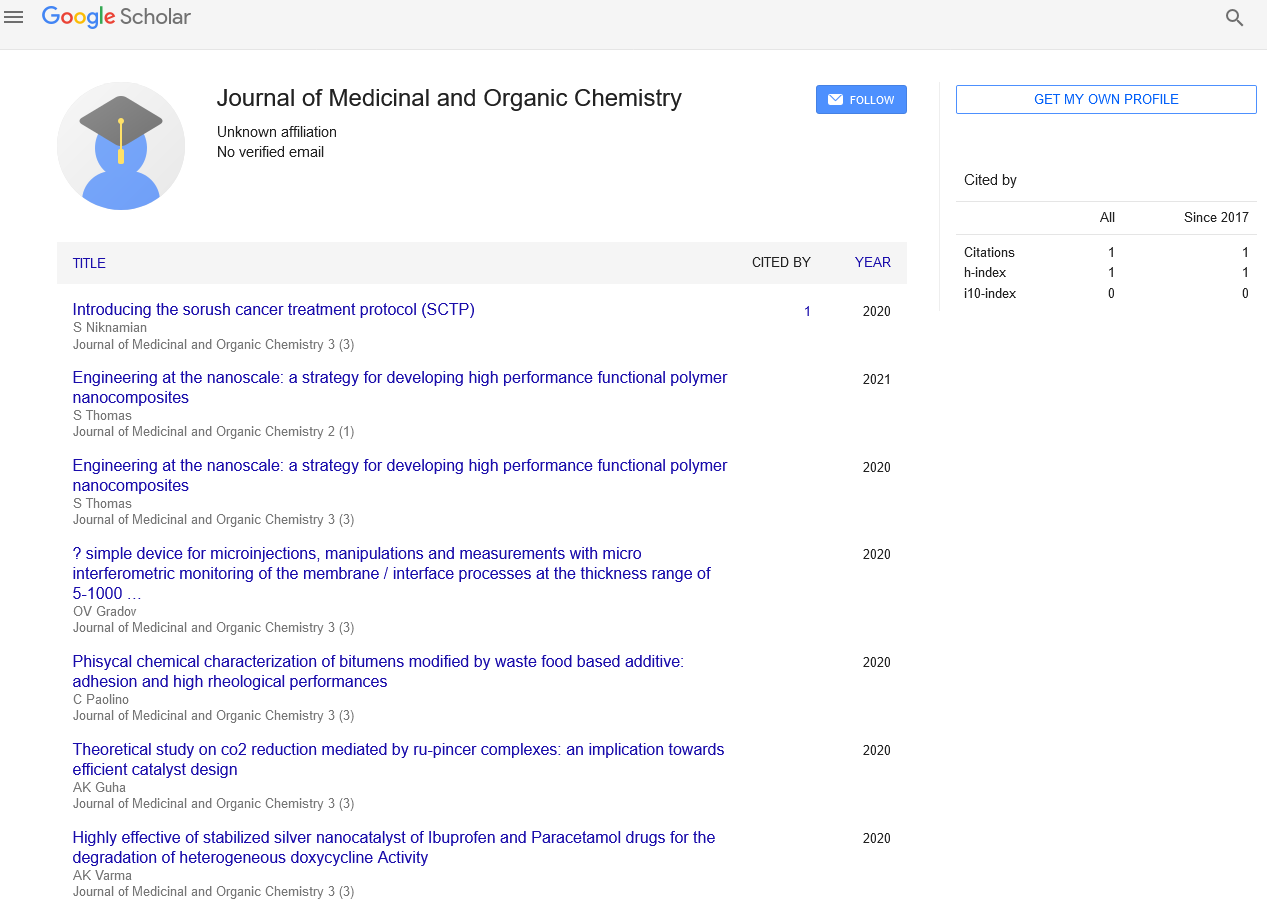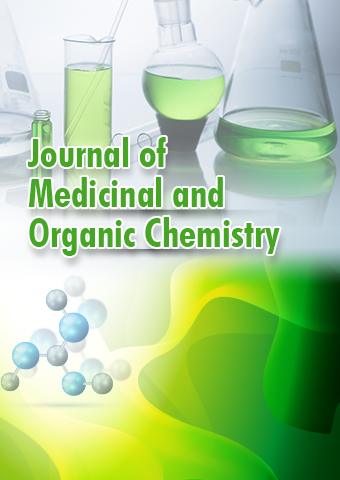Mini Review - Journal of Medicinal and Organic Chemistry (2023) Volume 6, Issue 3
Aromatic Compounds: Understanding the Fragrant World of Organic Chemistry
Dr. Yohei Yasuda*
Department of Emerging Infectious Diseases, Institute of Bioscience and medicine, Japan
Department of Emerging Infectious Diseases, Institute of Bioscience and medicine, Japan
E-mail: yohei.y@gmail.com
Received: 02-June-2023, Manuscript No. jmoc-23-101934; Editor assigned: 05-June-2023, PreQC No. jmoc-23- 101934; Reviewed: 19-June-2023, QC No. jmoc-23-101934; Revised: 23- June-2023, Manuscript No. jmoc-23- 101934 (R); Published: 30-June-2023; DOI: 10.37532/jmoc.2023.6(3).43-45
Abstract
Aromatic compounds are a class of organic compounds that possess unique structural and chemical properties. They are characterized by the presence of a stable, cyclic, conjugated system of π-electrons known as an aromatic ring. This distinctive feature gives rise to their characteristic odors and colors, as well as their wide range of applications in various fields, including pharmaceuticals, polymers, dyes, and materials science. In this abstract, we provide an overview of aromatic compounds, discussing their structure, bonding, aromaticity criteria, and reactivity. Furthermore, we highlight the significance of aromatic compounds in drug discovery, materials development, and environmental chemistry. Understanding the properties and reactions of aromatic compounds is crucial for advancing our knowledge in organic chemistry and exploring their potential in diverse areas of science and industry.
Keywords
Aromatic compounds • Aromaticity • π-electrons • Conjugated system • Organic chemistry • Structure • Bonding reactivity • Drug discovery • Materials science • Environmental chemistry • pharmaceuticals • Polymers • Dyes • Industry
Introduction
Aromatic compounds, also known as aromatics, are a fascinating class of organic compounds that possess a distinct and pleasant fragrance [1]. These compounds have captivated scientists and chemists for centuries due to their unique properties and their presence in a wide array of natural and synthetic products. In this article, we will delve into the world of aromatic compounds, exploring their structure, properties, and various applications.
Aromatic compounds form a fascinating and essential class of organic compounds that have captivated chemists for centuries [2]. These compounds, also known as aromatics, are characterized by a unique stability and a distinctive aroma, from which their name originates. Aromatic compounds are central to the field of organic chemistry and have a wide range of applications in various industries, including pharmaceuticals, agrochemicals, and materials science [3]. The defining feature of aromatic compounds is the presence of a special type of bonding known as aromaticity. Aromaticity arises from a cyclic arrangement of conjugated pi electrons in the compound’s structure. This cyclic arrangement leads to increased stability and unique chemical properties, making aromatics highly versatile and valuable in chemical reactions [4].
The most well-known aromatic compound is benzene, which consists of a six-carbon ring with alternating double bonds. Benzene, along with its derivatives, serves as a fundamental building block in the synthesis of countless organic compounds. Other common aromatic compounds include toluene, naphthalene, phenol, and aniline, among many others. Aromatic compounds possess distinct physical and chemical properties that set them apart from other organic compounds. They tend to be more stable, less reactive, and have higher boiling points compared to non-aromatic compounds with similar molecular weights. Aromatic compounds also exhibit unique reactivity, undergoing substitution reactions rather than addition reactions due to the preservation of the aromaticity during transformations [5].
Understanding the structure, properties, and reactivity of aromatic compounds is vital for chemists in various disciplines. Organic chemists rely on aromatic chemistry to design and synthesize novel compounds with desired properties. Medicinal chemists explore the aromaticity concept to develop new drugs targeting specific receptors and enzymes. Materials scientists utilize aromatic compounds to create polymers, dyes, and advanced materials with tailored properties [6].
Aromatic compounds represent a captivating and indispensable class of organic compounds. Their unique structure, stability, and reactivity make them essential in a wide range of industries and fields of study. By unraveling the secrets of aromatic compounds, scientists continue to unlock new possibilities for innovation and advancement in various domains.
Structure of aromatic compounds
The term “aromatic” originated from the fact that many early aromatic compounds were characterized by strong and pleasant odors. However, the term has evolved to refer to a specific class of compounds with a unique structure. Aromatic compounds are cyclic hydrocarbons or derivatives of hydrocarbons, which possess a planar, cyclic, and conjugated system of alternating single and double bonds [7]. The most common example of an aromatic compound is benzene (C6H6), which consists of a hexagonal ring of six carbon atoms with alternating single and double bonds.
The key feature of aromatic compounds is the presence of a conjugated pi electron system. This means that the pi electrons, which are involved in the double bonds, are delocalized over the entire cyclic structure. This delocalization of electrons contributes to the stability and unique properties of aromatic compounds.
Properties of aromatic compounds
Aromatic compounds exhibit several distinct properties that set them apart from other organic compounds. Some of these properties include:
Stability: Aromatic compounds are exceptionally stable due to the resonance or delocalization of pi electrons. This stability arises from the equal distribution of electron density throughout the ring, resulting in a lower overall energy state.
Aromaticity: Aromatic compounds display a property called “aromaticity,” which refers to their ability to exhibit a higher degree of stability and reactivity compared to non-aromatic compounds. A compound is considered aromatic if it fulfills the following criteria: it must have a cyclic, planar structure, possess a continuous ring of pi electrons, and follow Hückel’s rule, which states that the number of pi electrons in the cyclic system must be 4n+2, where n is an integer.
Odor: As the name suggests, aromatic compounds often possess strong and pleasant odors. These compounds are commonly found in perfumes, essential oils, and other fragrant substances. For example, vanillin, the compound responsible for the smell of vanilla, is an aromatic compound.
Solubility: Aromatic compounds are generally insoluble in water but exhibit varying solubilities in organic solvents. This solubility behavior is due to the nonpolar nature of aromatic compounds, which arises from the presence of carbon-carbon bonds and aromatic rings [8].
Applications of aromatic compounds
Aromatic compounds have widespread applications in various fields, owing to their unique properties and fragrance. Some notable applications include:
Perfumery and fragrance industry:
Aromatic compounds are extensively used in the production of perfumes, colognes, and other fragrances [9]. The unique and pleasant smells of aromatic compounds make them highly sought after by perfumers for creating captivating scents.
Pharmaceuticals: Many pharmaceutical drugs and active ingredients contain aromatic compounds. These compounds may contribute to the therapeutic effects of the drugs or act as structural components of the active molecule. The presence of aromatic rings in pharmaceuticals often influences their interactions with biological targets.
Polymers and plastics: Aromatic compounds find applications in the production of polymers and plastics. For example, polyethylene terephthalate (PET), a common plastic used in beverage bottles, contains aromatic rings in its structure [10].
Conclusion
Aromatic compounds represent a fascinating and important class of organic molecules. Their unique structure, characterized by a conjugated ring of atoms with alternating single and double bonds, gives rise to a host of interesting properties and reactivity. Aromatic compounds are widely encountered in nature and play crucial roles in various biological processes, such as the DNA double helix, neurotransmitters, and many essential natural products.
The discovery and understanding of aromaticity have revolutionized organic chemistry, paving the way for the development of new synthetic methodologies and the design of novel materials with tailored properties. The concept of aromaticity has also found applications in other scientific fields, including materials science, medicinal chemistry, and even in the development of advanced electronic devices. Throughout history, aromatic compounds have captivated the minds of chemists and have been the subject of intense research efforts. The elucidation of their structures and the development of theories to explain their unique stability and reactivity have provided valuable insights into the fundamental principles of chemical bonding and molecular behavior.
Furthermore, aromatic compounds have practical applications in numerous industries. They serve as the building blocks for the synthesis of pharmaceuticals, agrochemicals, dyes, polymers, and countless other important products. The development of efficient methods for the synthesis and functionalization of aromatic compounds continues to be an active area of research, aiming to enhance their accessibility and diversify their potential applications.
Aromatic compounds hold a central position in organic chemistry, offering a rich source of chemical diversity, structural complexity, and functional versatility. Their profound impact on science, technology, and everyday life is a testament to the enduring importance of these remarkable molecules. As research in this field progresses, we can anticipate further discoveries and advancements that will deepen our understanding and expand the scope of aromatic compounds, driving innovation and contributing to the advancement of various scientific disciplines.
References
- Petek BJ, Loggers ET, Pollack SM et al. Trabectedin in soft tissue sarcomas. Marine Drugs. 13, 974-83 (2015).
- Adams DD. autoimmune destruction of pericytes as the cause of diabetic retinopathy. Clinical Ophthalmology. 2, 295-298 (2008).
- Huang ES, Brown SE, Ewigman BG et al. (2007) Patient perceptions of quality of life with diabetes-related complications and treatments. Diabetes Care. 30, 2478-2483.
- Buehler AM, Cavalcanti AB, Berwanger O et al. Effect of tight blood glucose control versus conventional control in patients with type 2 diabetes mellitus: a systematic review with meta-analysis of randomized controlled trials. Cardiovascular Therapeutics. 31, 147-160 (2013).
- Huang ES, Brown SE, Ewigman BG et al. Patient perceptions of quality of life with diabetes-related complications and treatments. Diabetes Care. 30, 2478-2483 (2007).
- Buehler AM, Cavalcanti AB, Berwanger O et al. Effect of tight blood glucose control versus conventional control in patients with type 2 diabetes mellitus: a systematic review with meta-analysis of randomized controlled trials. Cardiovascular Therapeutics. 31,147-160(2013).
- Mamdouh N, Khattab A. YOLO-based deep learning framework for olive fruit fly detection and counting. IEEE Access. 9, 84252-8426 (2021).
- Brunelli D, Polonelli T, Benini L. Ultra-low energy pest detection for smart agriculture. IEEE Sens J. 1-4 (2020).
- Goyal M.Endovascular thrombectomy after large vessel ischaemic stroke: a meta- analysis of individual patient data from five randomised trials. Lancet. 22, 416-430 (2016).
- Headey D. Developmental drivers of nutrional change: a cross-country analysis. World Dev. 42, 76-88 (2013).
Indexed at, Google Scholar, Crossref
Indexed at, Google Scholar, Crossref
Indexed at, Google Scholar, Crossref
Indexed at, Google Scholar, Crossref
Indexed at, Google Scholar, Crossref
Indexed at, Google Scholar, Crossref

